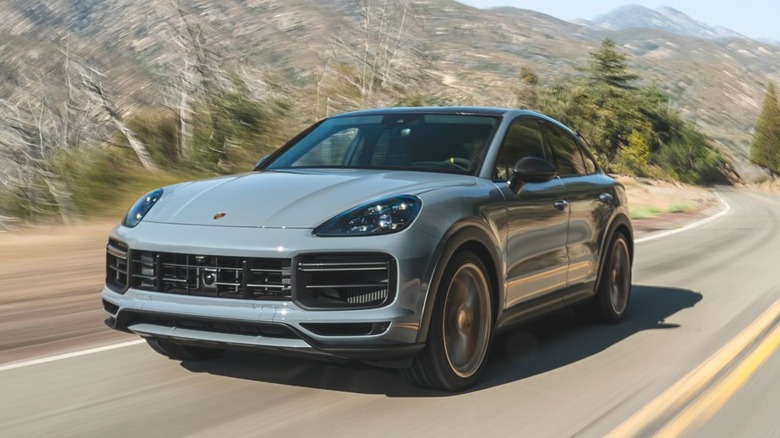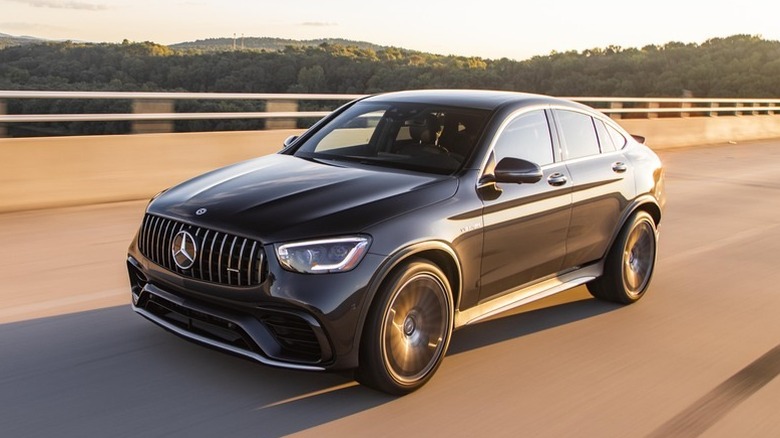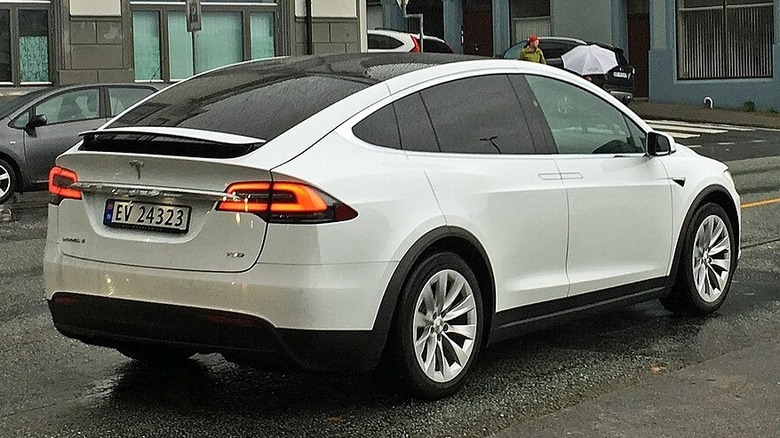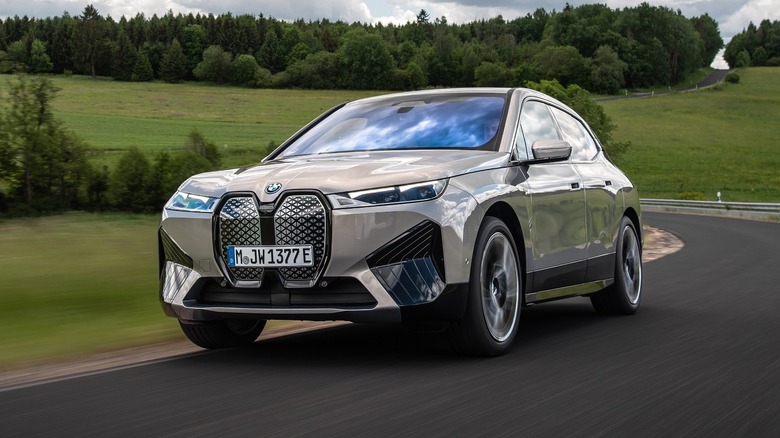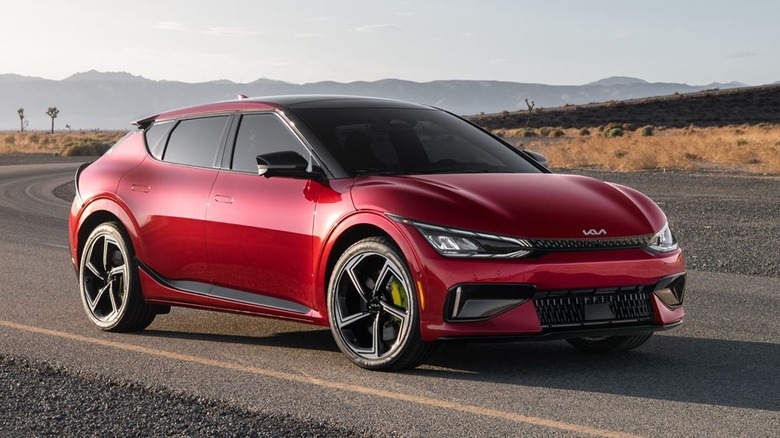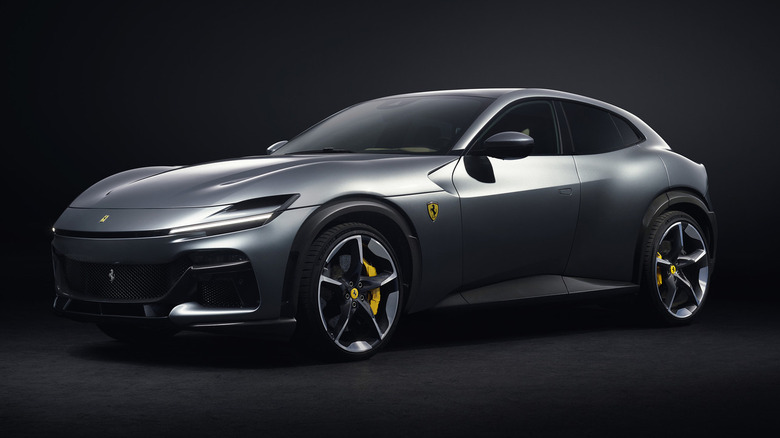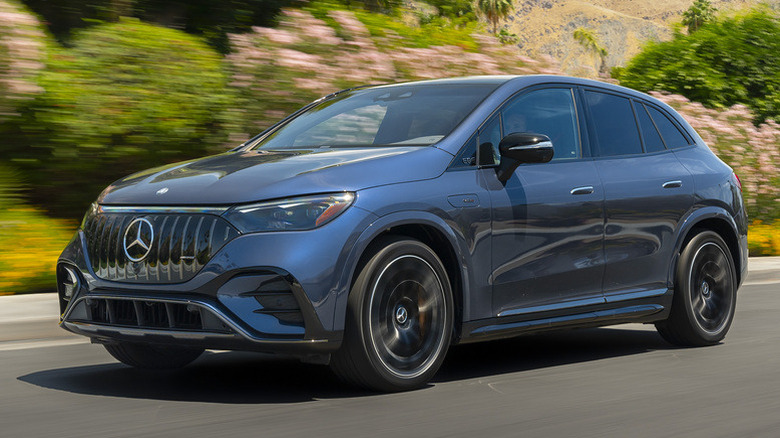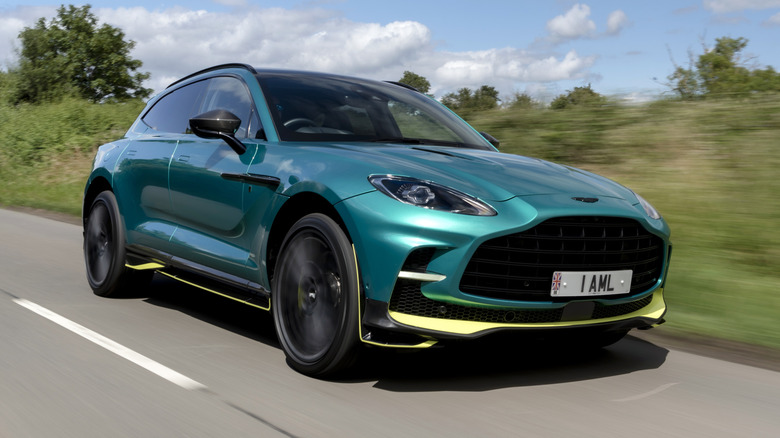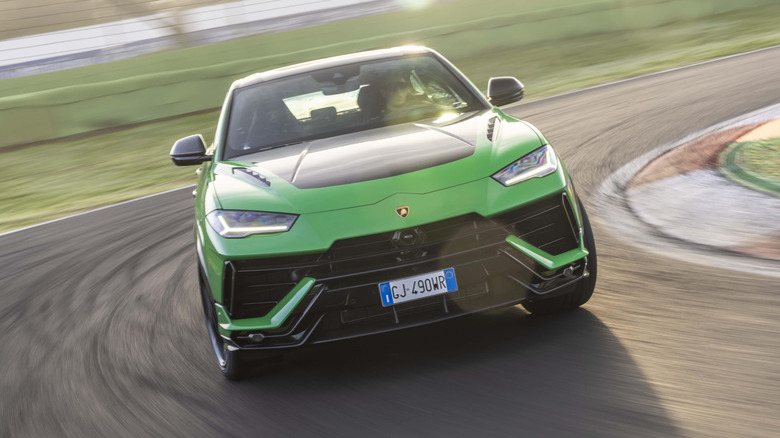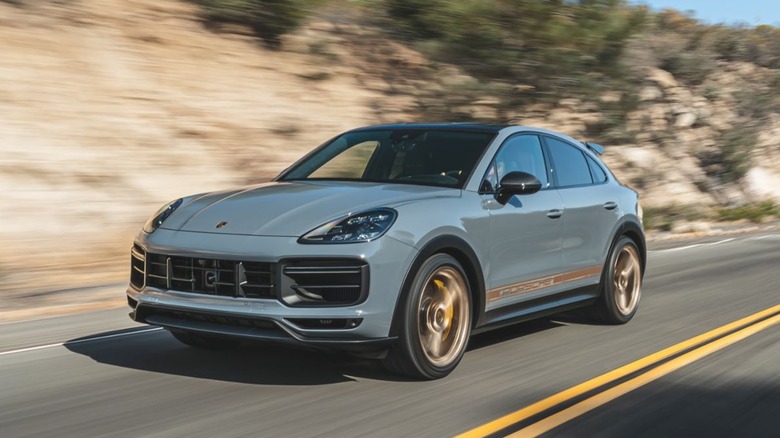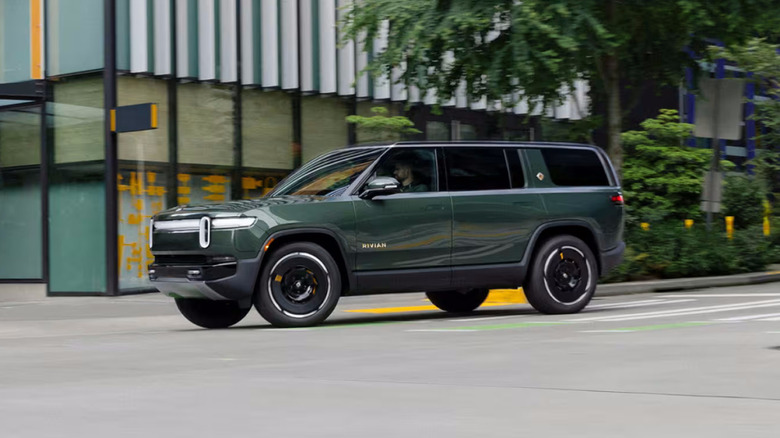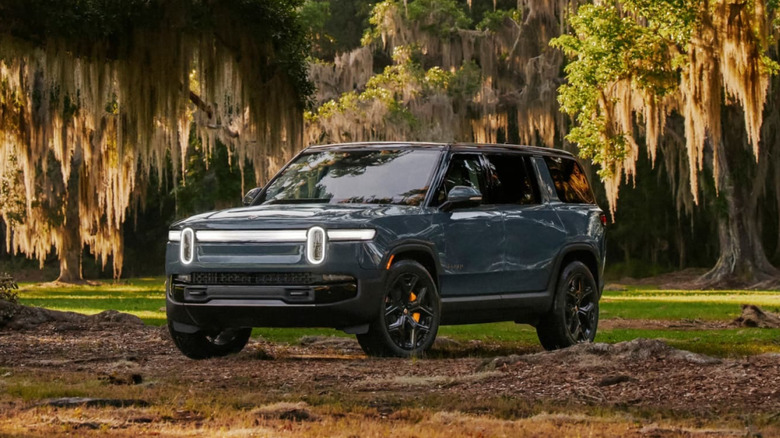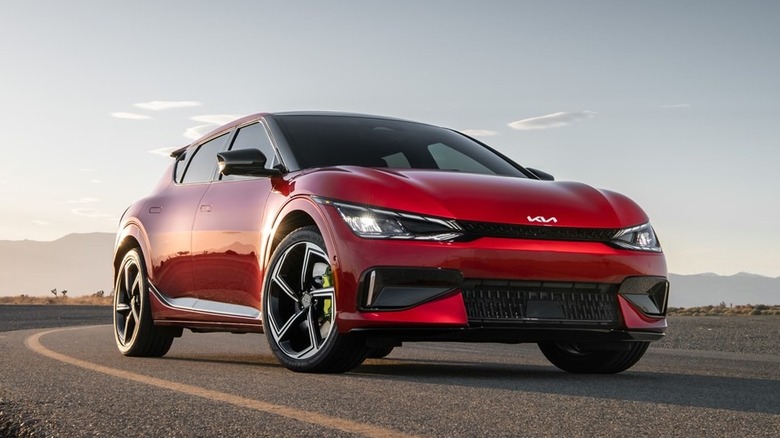13 Of The Fastest-Accelerating SUVs, Ranked By 0-60 Times
Discussing the fastest-accelerating SUVs seems perfectly ordinary as automakers of today are laser-focused on highlighting the sport aspect of the sport utility vehicle. A forefather of the modern SUV movement, the long-running Ford Explorer arrived in the early 1990s. In 1991, period testing revealed a 0-60 mph split of 10.4 seconds. In fairness, these Fords were powered by a naturally aspirated 4.0-liter V6 producing just 155 horsepower.
Looking over our speedy SUVs listed below, you'll note that the slowest example hits 60 mph from a standstill in 3.2 seconds. Only one of these utility-ish rockets is naturally aspirated, another makes more than 1,000 hp, and eight of the 13 fastest accelerating SUVs don't even use gasoline. In other words, SUVs have come a long way when it comes to outright speed.
Lest you think that old Explorer was a better off-roader, know that, as of 2025, there is a battery-powered SUV that can go from 0-60 mph in under 3 seconds, hit 10s in the quarter-mile, lope around trails with 15 inches of ground clearance, and wade through more than 3 feet of water. It's a good time to be alive for SUV fans, especially those who like to do their SUVing fast. To rank these models, we used multiple reputable sources for 0-60 mph splits and ordered them from slowest to fastest.
2018 Mercedes-AMG GLC63 S Coupe | 0–60 MPH: 3.2 Seconds
The Mercedes-AMG GLC63 S Coupe is one of several ICE-powered SUVs that rely on a 4.0-liter twin-turbo V8 for motivation. For 2018, it made 503 hp and 516 lb-ft of torque, that latter metric being fully on tap at just 1,750 rpm. This helps when slinging a 4,500-pound SUV to highway speeds from a standstill. Although it ties with four other models as the slowest on this list, it's worth noting that just 0.6 seconds separates it from the fastest. The Panamericana front grille shared with Mercedes' AMG GT sports car is a visual cue that this crossover coupe was built for speed.
As are the Michelin Pilot Sport 4S summer tires with a 295 section width out back. Set to Race mode, the GLC63 S will stiffen its air springs and drop its ride height. Activate the launch control sequence, stand on the brakes, and floor the throttle to see what this kind of speed feels like. For those who are suddenly overwhelmed by sensations of "What have I done!", rest easy knowing the range-topping GLC is packing carbon ceramic brakes — as it should with sticker price that ran as high as $104,910.
2016 Tesla Model X P90D Ludicrous | 0–60 MPH: 3.2 Seconds
It's been almost 10 years since Tesla launched its first foray into Spaceballs-themed electric SUVs, and yet, the 2016 Model X P90D Ludicrous remains one of the fastest-accelerating SUVs out there. The alphabet soup naming convention was an early Tesla approach that correlated with the 90-kWh battery pack in these range-topping Xs. Of course, the zany Falcon Wing doors were as noteworthy as the impressive stoplight drag racing capabilities. Weighing in at 5,594 pounds, the 2016 Model X opened auto industry eyes to the physics-defying possibilities of battery power.
The Ludicrous Speed option bumped battery pack output from 1300 to 1500 amps, while delivering 532 hp and 713 lb-ft of instantaneous torque. Another performance metric that put the industry on EV notice was a 30-50 mph split of 1.3 seconds. For reference, the latest Porsche Cayenne Turbo GT Coupe requires 2.9 seconds to do the same thing. Featuring three rows of seating, a maximum cargo hold of 68 cubic feet, and a 250-mile driving range, these hot rod Model Xs get credit for proving that electric SUVs were ready to go mainstream.
2023 BMW iX M60 | 0–60 MPH: 3.2 Seconds
It took a while, but BMW finally caught up to Tesla in the EV SUV race with the iX lineup that arrived in 2022. At the top of this series is the M60 super-SUV. Though similar in size to the ICE-powered X5, these BMWs are dramatically different. Aside from the powertrain, the iX features a structure composed of high-strength steel, aluminum, plastic, and carbon fiber. It comes with standard air springs, rear-wheel steering, 22-inch wheels, and 13.7-inch front brake rotors. That latter spec is important when you consider the iX M60 weighs nearly 5,800 pounds, while producing 610 hp and 811 lb-ft of torque.
Utilizing dual motors, one at either end, and all-wheel drive, the M60 is a rocket to 60 and clears the quarter-mile in 11.5 seconds at 122 mph. Like the other EV SUVs here, the BMW has the ability to go from 30-50 mph in under 2 seconds. That's the kind of fleetness that will likely require a mental adjustment from drivers on how fast they can make quick maneuvers. You will pay dearly for it, however, as the iX M60 started as high as $119,000 when loaded with optional touches like 22-inch aero wheels and summer performance rubber.
2023 Kia EV6 GT | 0–60 MPH: 3.2 Seconds
True to its roots, the value-oriented Kia EV6 GT is almost 50% cheaper than the ix M60, with a sticker that ran to $63,400. For that outlay, you get dual electric motors, a 77.4-kWh battery pack, 576 hp, and 545 lb-ft of torque. It'll match the BMW in the 0-60 race and edge it in the quarter-mile by one-tenth of a second. Not only that, the EV6 GT, which is the top dog in the EV6 lineup, can cling to the skidpad with 0.92 g of lateral grip. Chalk that up, in part, to the 255 section-width 21-inch Goodyear Eagle F1 tires, adaptive dampers, and electronically-controlled limited-slip differential (eLSD).
Credit to Kia for delivering this level of performance from a vehicle that weighs 4,772 pounds. Setting the EV6 GT to Eco mode can help improve driving range, but it limits access to 288 hp. That's exactly half the max output and shines a light on the versatility of electric powertrains. However, for serious driving excitement, you'll want all the electrons, as the available Drift mode encourages tire smoking shenanigans.
2024 Ferrari Purosangue | 0–60 MPH: 3.2 Seconds
Among the current crop of fastest accelerating SUVs, only the Ferrari Purosangue offers the aural thrill of a naturally aspirated V12 engine, along with the Italian automaker's signature red-painted valve covers. It'll cost you a cool $400,000 just to get in the door, but hey, it's a Ferrari SUV. With 715 hp, 528 lb-ft of torque, and an 8,000-rpm redline, the Purosangue redefines the SUV and is the antithesis of silent electric propulsion. It's also the only SUV here with so-called coach back doors that open up, via power operation, to a pair of second-row bucket seats.
Trick Multimatic spool-valve dampers are on hand to keep the Purosangue planted during wide-open runs, as is rear-wheel steering, staggered 22- and 23-inch rubber, and individual 48-volt electric motors at each corner that work to remove body roll. Keep your foot in it, and the 4,850-pound Ferrari will clear the quarter in 11.7 seconds, then run up to a 193-mph top end. New for 2024, Ferrari's SUV will be one of the final vehicles from Maranello to feature a free-breathing 12-cylinder powerplant, which is somewhat ironic for a brand known for sports cars.
2022 Rivian R1S Launch Edition | 0–60 MPH: 3.1 Seconds
Rivian's follow-up to its R1T pickup truck was the R1S three-row SUV that arrived with a Launch Edition model capable of wickedly fast 0-60 runs. With four motors, two up front and two out back, these early R1Ss were rated for 835 hp and 908 lb-ft of torque. Considering how they crush the scales at very nearly 7,000 pounds, the performance of these Rivians is truly eye-popping.
The $99,000 price tag is high, but not out of line with its peers, plus the R1S can tow up to 7,700 pounds and go 316 miles on a full charge. That is largely due to the relatively big 129-kWh battery pack in these models, as the heavy 22-inch 275/50 Pirelli Scorpion all-season tires are not doing it any favors on this front.
Not only is the R1S one of the fastest-accelerating SUVs on the market, it can also ford 39 inches of water and deliver 15 inches of ground clearance via the standard air suspension. There are few vehicles that offer this tremendous level of versatility, but incredibly, Rivian's SUV has only gotten better with age, as we'll see below.
2024 Mercedes-AMG EQE | 0–60 MPH: 3.1 Seconds
The SUV member of the Mercedes EQ subbrand of EVs, the EQE, is perhaps the most blandly styled SUV here. That is an intentional sacrifice for improved aerodynamic efficiency, a key aspect of increasing driving range on EVs. All of which will likely be quickly forgotten when piloting the EQE in AMG spec with the AMG Dynamic Plus package. That setup unlocks the maximum output of the EQE's 90.6-kWh battery-powered dual motor setup. It measures 677 hp and 738 lb-ft of torque. Hitting 60 in 3.1 seconds requires the use of Mercedes' Race Start launch control system.
Buyers can spend more than $130,000 on the 2024 AMG EQE, but it is the first electric Mercedes SUV to don the AMG badge and comes laden with features to justify the high price. Like a "water lance" cooling system on the motors, which uses a hollow shaft within the rotor to circulate coolant, and features specially shaped ribs on the motor's stator. Then there are the optional massive 17.3-inch carbon-ceramic front brakes, 21-inch Michelin Pilot Sport EV tires, and AMG Ride Control suspension. It's an impressive package deserving the AMG badge of honor.
2023 Aston Martin DBX 707 | 0–60 MPH: 3.1 Seconds
The standard Aston Martin DBX makes 542 hp, which is quite healthy, but you'll be wanting the 707 variant to tap the more outrageous output figure of 697 hp. In European power parlance, that translates to 707 PS, hence the moniker. There's also the 663 lb-ft of torque that comes courtesy of a 4.0-liter twin-turbo V8. If that spec sounds familiar, it's because the engine comes from Mercedes-AMG, as does the nine-speed automatic. The engine of identical displacement and forced induction found in the Porsche Cayenne and Lamborghini Urus that Aston benchmarked, however, is unrelated.
For the DBX 707, Aston Martin went all-out on performance, fitting it with carbon-ceramic brakes at all four corners, 23-inch Pirelli P Zero summer tires, air springs, an eLSD, and an active anti-roll system. This translates to 0.94 g of lateral grip, a claimed 193-mph top speed, and an 11.5-second quarter-mile at 119 mph. Even more impressive given the DBX 707's 5,128-pound curb weight. All that power and prestige will come at a cost, however, with the 707 variant pushing up close to $300,000 for a well-equipped model.
2023 Lamborghini Urus Performante | 0–60 MPH: 3.0 Seconds
All of these super-fast SUVs boast incredible accelerative power, but somehow, 3 seconds flat just sounds that much more impressive than 3.2 seconds. It's a figure reserved for only a few exotic models, the Lamborghini Urus Performante being one of them.
Like its Porsche Cayenne corporate cousin, the range-topping Urus is powered by a twin-turbo 4.0-liter V8 making 657 hp at 6,000 rpm and 627 lb-ft of torque at 2,300 rpm. Top speed measures 190 mph for those who dare. Barely street-legal Pirelli P Zero Trofeo R rubber measuring 285/40 up front and 325/25 out back wraps around 22-inch wheels, all in the name of maximizing traction.
It helps with the rocket ride to 60, while the Performante's exclusive steel-sprung suspension that lowers the SUV by 0.8 inches lends a hand in the seemingly impossible 1.04 g of lateral grip this hottest of Urus' can manage. Lamborghini also shaves 104 pounds for the Performante via carbon fiber body panels and deleted sound deadening materials. All of which adds up to a price tag of some $340,000 that includes the completely necessary $19,000 Viper Green paint job.
2025 Hyundai Ioniq 5 N | 0–60 MPH: 3.0 Seconds
Like its Kia EV6 brethren, the Hyundai Ioniq 5 N is almost comically value-packed in this fancy company. Slotting between the $340,000 Lambo and $202,000 Cayenne Coupe, the fully-loaded price tag of $68,685 for an Ioniq 5 N seems like the bargain of the century. Which it is if 0-60 times are your measuring stick and you don't need a snooty badge on your car to know it's excellent. The Ioniq 5 N boasts 641 hp and 568 lb-ft of torque, delivered via the N Grin Boost function, along with 15.7-inch front brake rotors, 21-inch Pirelli P Zero tires, and 0.96 g of skidpad grip.
The Ioniq also holds 59 cubic feet of cargo and has perhaps one of the most interesting designs of any SUV here. A total sleeper, the 5 N looks cool with retro-styled pixelated LED light treatments, but may get a bit too silly with its synthetic rumbles and pops simulating gear changes and ICE acceleration. This is an EV, to be clear, one with an 84.0-kWh battery pack, 221-mile range, and paddle shifters. It also offers a dedicated Drift mode for when roasting rubber is more important than smoking Ferraris.
2024 Porsche Cayenne Turbo GT Coupe | 0–60 MPH: 2.8 Seconds
The fastest accelerating SUV powered by internal combustion is the Porsche Cayenne Turbo GT Coupe. Marginally down on power versus the Urus Performante with which it shares a twin-turbo V8, the Porsche is still very potent. Output measures 650 hp at 6,000 rpm and 626 lb-ft of torque at 2,300 rpm. An eight-speed automatic routes power to all four wheels, and the 4,994-pound fastback SUV rockets to 60 in under 3 seconds, putting it in rarefied air. It'll also clip the quarter-mile in 11.2 seconds at 121 mph, top out at 189 mph, and circle the skidpad with 1.02 g of grip.
To say this is a far cry from the '91 Ford Explorer, the O.G. of ICE SUVs, is an understatement. The Cayenne will only hold four passengers and can crack $200,000 when fully loaded, but that's a 50% discount versus Ferrari's four-seater. Exclusive to the U.S. market, this particular Cayenne variant comes with a carbon fiber roof, Pirelli P Zero tires wrapping 22-inch wheels, adaptive air springs, and manages to produce 302 more horsepower than its base Cayenne sibling. Impressive.
2025 Rivian R1S Tri | 0–60 MPH: 2.8 Seconds
For 2025, Rivian overhauled the R1S lineup with more power across the board for its in-house designed and built electric motors. In doing so, it created the R1S Tri, a triple-motor variant that has higher output figures than the quad-motor Launch Edition from 2022. The battery pack holds 92.5 kWh of capacity, the 850 hp output represents only a 15-hp increase, but the 1,103 lb-ft of torque on these revamped models is a jump of nearly 200. An all-new electrical architecture helps the R1S drop 44 pounds while new air springs, a revised adaptive damper tuning, and an updated hydraulic roll-mitigation system aim to improve driving dynamics.
Skidpad grip, water fording depth, maximum ground clearance, and towing metrics are all unchanged. However, the updated R1S Tri shaves 0.3 seconds in the 0-60 mph sprint to get comfortably below the 3-second mark at 2.8 seconds. It also runs the quarter-mile with a trap speed of 121 mph. If this Rivian doesn't quite cut it for you, the American EV automaker has an even faster option.
2026 Rivian R1S Quad | 0–60 MPH: 2.6 Seconds
Arriving for the 2026 model year, Rivian is bringing back a four-motor example of its R1S, dubbed simply the Quad. This name and the understated exterior make the R1S Quad one of the all-time greatest sleepers. With a 140-kWh battery pack, this R1S is rated for 1,025 horsepower and 1,198 lb-ft of torque. It weighs 6,950 pounds, yet still accelerates from 0 to 60 in just 2.6 seconds. It is the only one of our fastest accelerating SUVs to drop into the 10s for the quarter-mile, specifically 10.5 seconds at 128 mph, and yet, the $128,000 price point makes it a relative bargain compared to some of the more exotic models on the market.
Along with special Laguna Blue brake calipers, one of the few visual giveaways of the Quad, it features new hardware and software that enable fully independent control of each wheel. With a motor at each corner, the R1S Quad can slow, stop, or even reverse its inside wheels during maneuvering. Rivian calls it the Kick Turn and notes how handy it is for off-road situations because you can, in fact, run the R1S hard off-road, after blowing the doors off all comers on your way to the trail.
Methodology
All 0-60 mph times were sourced from reputable outlets, including Car and Driver, Motor Trend, and Road & Track. Vehicles were ranked slowest to fastest, while those with identical splits were ordered randomly. When 0-60 times varied by 0.1 seconds between sources, the faster time was cited for ranking purposes.
